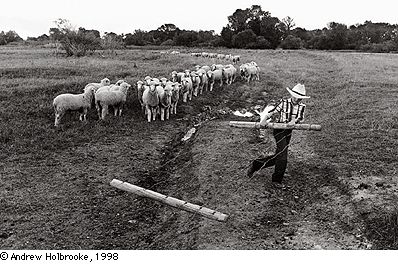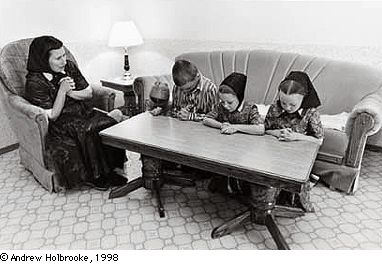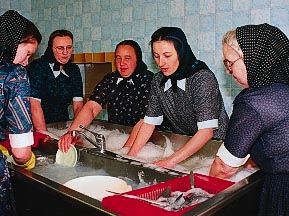Hutterites
One person wrote, "Hutterian  Brethren
(or Hutterites) is a Christian sect similar to Mennonites except for their belief in the
common ownership of things. They got their name from their leader, Jakob Hutter who was an
Anabaptist minister burned as heretic in Innsbruck 1536. They found refuge from
persecution in Moravia. They stressed community of goods. Persecutions drove them to
Hungary, Ukraine, and South Dakota in the 1870s. They migrated to Canada during World War
I because of persecution associated with pacifist beliefs. Their communities in the U.S.
and Canada total about 20,000 members with colonies of 60 to 150 persons who operate
collective farms that remain apart from politics and society."
Brethren
(or Hutterites) is a Christian sect similar to Mennonites except for their belief in the
common ownership of things. They got their name from their leader, Jakob Hutter who was an
Anabaptist minister burned as heretic in Innsbruck 1536. They found refuge from
persecution in Moravia. They stressed community of goods. Persecutions drove them to
Hungary, Ukraine, and South Dakota in the 1870s. They migrated to Canada during World War
I because of persecution associated with pacifist beliefs. Their communities in the U.S.
and Canada total about 20,000 members with colonies of 60 to 150 persons who operate
collective farms that remain apart from politics and society."
"The largest of modern religious communal sects is the Hutterian Brethren. They
came to North America in 1874 to 1877 and now live in about 155 villages in western
Canada, South Dakota, and Montana. They support themselves through farming, stock raising,
and other work."
The Hutterite community is the only communal religious society I know of that has
continued since the 19th century. These people incorrectly believe that God is a
pacifist. Satan gets them to misread the Bible. They are socialist because they feel the
Bible expouses communism in Acts: 4:32 that shows that the early Christians lived
that way: "Now the whole group of those who believed were of one heart and
soul, and no one claimed private ownership of any possessions, but everything they
owned was held in common." In verses 34 and 35 they write what all socialists
dream of mankind doing, " There was not a needy person among them, for as many
as owned lands or houses sold them and brought the proceeds of what was sold. They
laid it at the apostles' feet, and it was distributed to each as any had need."
An article on the Hutterites in smithsonian magazine said, "The work of a
Hutterite colony is divided along traditional gender lines, and is usually performed in
accordance with a strict schedule. In this Montana colony, the women do laundry twice a
week in the group's large machines. Unlike the Amish, the Hutterites have incorporated
much modern technology into their lives. Their buildings are electrified, their farm and
manufacturing equipment up-to-date; some colonies have Web pages on the Internet."
To be a Hutterite is first of all to be a member of a community, a tiny part of an
integrated whole. In small colonies these Christians live in shared buildings, eat in
common dining rooms, labor and worship together. They hold no personal property, and have
little contact with those outside their community. This, they believe, is God's plan.
Like the Amish and Mennonites, the Hutterites are descended from the 16th-century
Anabaptists, whose condemnation of infant baptism made them heretics. These pacifists take
their name from an early leader, Jacob Hutter. After moving around eastern Europe for
three centuries to avoid persecution, they immigrated to the United States in the 1870s.
They have thrived here. More than 35,000 Hutterites now live in roughly 400 colonies
in Montana, Washington, the Dakotas, Minnesota and western Canada. Most Hutterite colonies
support themselves through agriculture, some through the manufacture of such salable items
as hog feeders and coal boilers. No one draws a salary for this work; each person's needs
are provided for by the colony.
Photographer Andrew Holbrooke has visited several Hutterite colonies. His images
reveal a people whose distinctive ways unite them, and the charm of small moments in a
life apart.
In Alberta, Canada, a mother supervises her children at evening prayer before
putting them to bed; nuclear families typically live in small apartments in a communal
building. Children are taught from an early age the central importance of prayer and work
in a Hutterite community. Each day in a colony begins and ends with prayer, in recognition
that the first duty of the faithful is obedience to God.
All members of the colony are provided for equally and nothing is kept for personal
gain. Hutterites do not have personal bank account; rather all earnings are held
communally and funding and necessities are distributed according to one's needs.
Hutterites attend a 1/2 hour church service almost every day besides a 1 to 1 1/2
hour service every Sunday and common religious holiday. About 36 000 Hutterites are
living on 428 colonies in North America today. Each Hutterite colony has to provide for
between 60 and 160 persons. There are normally eight houses in one unit, and each
house is home to one Hutterite family. The main floor of each house has several bedrooms,
a sitting room, and a bathroom. None of the homes have kitchens; rather, a large kitchen
and communal dining room are located in the centre of the colony, adjacent to the church.
In Hutterite Society by John A. Hostetler we read "Of hundreds of
recorded attempts to establish communal societies in North America, the Hutterites are the
only group that has managed not only to survive but to expand and prosper. Yet the members
work without the incentive of private gain, and privileged positions are few. There are no
extremely poor or wealthy persons among them, and individuals never worry about food,
shelter, clothing or dependency in old age. Identity problems and alienation are virtually
nonexistent. In their history, which spans more than four centuries, there has never been
a single homicide. There are no high walls around the colony and no police force."
"Although they are not attempting to achieve a utopia, the Hutterites have in
fact realized some utopian goals: the elimination of extreme poverty or wealth, enjoyment
of cooperative work, motivation without the incentive of private profit, an effeftive
system of education and security for the individual. As in his prvious book, "Amish
Society", Hostetler combines objectivity with sensititvity to human values in
understanding community self-realization."
"At a time of growing interest in communal societies and alternative
lifestyles, John. A. Hostetler offers a complete and fascinating picture of the oldest and
largest family-style communal society in North America. Believing that the communal
structure is ordained by God, the Hutterites regard each colony as a Noah's Ark, a
God-given provision for living in a world that is otherwise hopelessly lost."







 Brethren
(or Hutterites) is a Christian sect similar to Mennonites except for their belief in the
common ownership of things. They got their name from their leader, Jakob Hutter who was an
Anabaptist minister burned as heretic in Innsbruck 1536. They found refuge from
persecution in Moravia. They stressed community of goods. Persecutions drove them to
Hungary, Ukraine, and South Dakota in the 1870s. They migrated to Canada during World War
I because of persecution associated with pacifist beliefs. Their communities in the U.S.
and Canada total about 20,000 members with colonies of 60 to 150 persons who operate
collective farms that remain apart from politics and society."
Brethren
(or Hutterites) is a Christian sect similar to Mennonites except for their belief in the
common ownership of things. They got their name from their leader, Jakob Hutter who was an
Anabaptist minister burned as heretic in Innsbruck 1536. They found refuge from
persecution in Moravia. They stressed community of goods. Persecutions drove them to
Hungary, Ukraine, and South Dakota in the 1870s. They migrated to Canada during World War
I because of persecution associated with pacifist beliefs. Their communities in the U.S.
and Canada total about 20,000 members with colonies of 60 to 150 persons who operate
collective farms that remain apart from politics and society."



